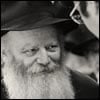This is the sign of the covenant... I have placed My rainbow in the cloud... and the rainbow will be in the cloud."1
These verses are the subject of a maamar that was just printed2 that appears to be from the Alter Rebbe.3 At the beginning of the maamar, he cites the question raised by the commentaries:4 `of the institution of the rainbow after the flood (and [its designation as] "the sign of the covenant")? On the surface, the rainbow is a natural phenomenon. When the sun shines at one side of the sky and there are clouds at the opposite side, a rainbow is formed in the clouds.
The question can be resolved by explaining the spiritual counterpart of a cloud (concerning which it is said: "I have placed My rainbow in the cloud"). In that context, two explanations are offered:
a) A positive one which explains that a cloud reflects very high levels. When there is a very high revelation that cannot be received otherwise, the cloud makes it possible for the revelation to be received. This parallels the interpretation of the verse:5 "for the sun and [its] shield are Havayah and Elokim." Just as it is impossible to look at the sun except through a shield, so too, it is impossible to receive the revelation of the [spiritual] sun, Havayah unless [the revelation is filtered through] the shield of G‑d's name Elokim.
The cloud served this purpose at the time of the Giving of the Torah, as it is written:6 "And Moses entered into the midst of the cloud." Since the revelation at the time of the Giving of the Torah was very elevated, there was a necessity for the cloud to serve as a "garment" so that revelation could be received [and internalized]. Indeed, the source of the cloud is even higher than the revelation, for the cloud stems from the level [of which it is said:]7 "He made darkness His concealment."
A similar concept applies with regard to the cloud formed by the incense offering of Yom Kippur that comes about through the service of teshuvah. This reflects the highest level of a cloud, the level [of which it is said:] "He made darkness His concealment."
b) There is also a negative interpretation of a cloud that reflects a great descent. Due to the multitudinous chainlike descents, veils, and curtains in the spiritual realms, including the breaking of the vessels of the realm of Tohu, from the cloud of holiness is brought into existence,8 * a cloud that represents utter hiddenness and concealment. For this reason, sins and transgressions are described with the analogy of a cloud, as it is written:9 "I have wiped away your transgressions like mist and your sins, like a cloud." For a cloud is a covering that separates, as it is written:10 "Your sins caused separation...," as explained at length in Tanya.11
Just as there are these two dimensions with regard to the spiritual parallel to a cloud (a cloud whose purpose is revelation and a cloud associated with utter concealment and hiddenness), there are two such dimensions two clouds as they exist in the material realm. There are light clouds that make it possible to look at the sun (at least momentarily) and there are clouds that are entirely opaque. In that vein, our Sages say:12 "A cloudy day is difficult, like the day of judgment," for they are both reflective of the quality of judgment.
On this basis, it is possible to understand the concept that the rainbow came into existence only after the flood. Before the flood, the world was not refined. Therefore there were clouds which the light of the sun could not penetrate so that it could be revealed through them. Therefore it was impossible for the colors of a rainbow to exist. However, after the flood which brought about the refinement of the world, lighter clouds came into being and through [interaction between] them [and the sun's rays], the colors of the rainbow could be seen.
The cloud whose purpose is revelation is related to the concept of teshuvah, like the cloud of the incense offering of Yom Kippur that is a reflection of the teshuvah of Yom Kippur. To explain: In a physical sense, [rain] clouds come into existence because "a mist ascended from the earth and watered...," i.e., their source is the earth below the heavens. Similarly, the spiritual counterpart of a cloud comes into being from Divine service on this material plane, the service of teshuvah.
As is well known, the space between the earth and the sun is divided into three areas: the area close to the sun is very hot; the empty space between the sun and the earth is very cold, and the atmosphere that is close to the earth is warm again, because the light of the sun spreads out [and is captured within] for the surface of the earth prevents it from extending further and causes it to rebound. [In Kabalistic terms,] this is referred to as or chozer and is identified with the service of teshuvah.
Teshuvah which is identified with this or chozer brings about a rainbow that has three colors. Implied is that the service of teshuvah must encompass the three vectors [of spiritual emotions]: chesed (kindness), din (judgment), and rachamim (mercy).13 Through teshuvah on this earthly plane as expressed in these three vectors, we draw down the rainbow and its three colors from above. These represent the sublime expressions of these three qualities and bring about the nullification of the parallels to these qualities in the realm of evil to the extent that "I have wiped away your transgressions like mist," wiping them away entirely, [by bringing about] their refinement.
On this basis, we can understand the verse: "This is the sign of the covenant... I have placed My rainbow in the cloud." Through the service of teshuvah, the positive counterpart of a cloud is brought about. And it is the clouds that bring about all the blessings: "I will give your rains in their season," and [seal them] as a covenant, "All the days of the earth... cold and heat... (i.e., the six seasons of the year) will never cease."
Moreover, it is possible to explain that the rainbow brought about by the clouds possesses an advantage over all the blessings that are drawn down by the cloud. This is reflected in our Sages' comment on the verse:14 "I have placed My rainbow in the cloud," stating that the rainbow (keshet) alludes to "something resembling Me."15 This transcends all revelations, for it "resembles Me," G‑d's Essence, as indicated by the verse:16 "Like the appearance of the rainbow in the cloud... so is the appearance of G‑d's glory." And this is all given to mankind as a covenant, i.e., a bond that unites those who participate in the covenant, making them a single entity.17
On this basis, we can appreciate the statement of the Zohar18 quoted in the maamarim of the Rebbe Maharash:19 "Do not expect the coming of Mashiach until the rainbow is seen... in shining colors." For the rainbow alludes to the concept of teshuvah as expressed in the three vectors [of Divine service] alluded to by those colors. Hence, [when this service is carried out, it is appropriate to] "expect the coming of Mashiach." For Mashiach is identified with the concept of teshuvah, as it is said:20 "Mashiach will motivate the righteous to turn to G‑d in teshuvah." Arousing the spark of Mashiach — which is identified with teshuvah — that exists within every righteous man will lead to the revelation of Mashiach for all mankind.
May it be G‑d's will that our deeds and Divine service in the era of exile in general, and, particularly, through the study of these concepts in the Torah, arouse a remembrance of the covenant with Noach in general and particularly, of the rainbow. The remembrance of Noach is also mentioned in the Zichronos blessings of Rosh HaShanah, because it is an eternal remembrance, connected to the essence of the Jewish people.21 This matter is hidden on Rosh HaShanah, but is drawn down through the cloud of the incense offering of Yom Kippur, which is the unique day of the year. Afterwards, the 100 shofar blasts of Rosh HaShanah are drawn down through the s'chach of the sukkah, because s'chach (סכך) is numerically equivalent to 100. Indeed, the name sukkah (סוכה) derives from the s'chach. Through this, we will merit, very soon, to sit in the sukkah [made from] the hide of the Leviathan,22 the sukkah of peace,23 with the coming of Mashiach.
It was explained above that when the colors of the rainbow shine forth, one should expect Mashiach's coming. In particular, this is true in the era of ikvesa deMashicha when "the feet meet the feet."24
(The concept of feet is associated with the three pilgrimage festivals, when the Jewish people would ascend to the Beis HaMikdash. In the ultimate future, this will take place on every Shabbos and Rosh Chodesh. The clouds will bring them, as stated in the Yalkut Shimoni,25 commenting on the verse:26 "Who are these who fly like clouds, like doves to their dovecotes?", as explained by in a maamar of the Rebbe Rashab.27 Then the clouds of holiness will bring the Jews to the Beis HaMikdash on every Shabbos and every Rosh Chodesh, "com[ing] on the clouds of heaven."28 )
Then we must "expect Mashiach's coming. And in the very near future, "You, children of Israel, will be gathered one by one."29 Every Jew will come individually on the clouds of heaven to the Beis HaMikdash. And just as one will come to present himself before G‑d, he will come to see [G‑dliness] in a revealed manner in the true and complete Redemption. As explained with regard to the phrase:30 "Those who taste it merit life," before Shabbos, one must taste from every dish to be served on Shabbos. Similarly, before the coming of Mashiach, we must experience a foretaste of that future era; "Kings will be your nurturers."31 And we will merit the true and ultimate redemption, coming with the clouds of heaven, led by Mashiach.
Click here to download a printable version with the Hebrew text













Start a Discussion